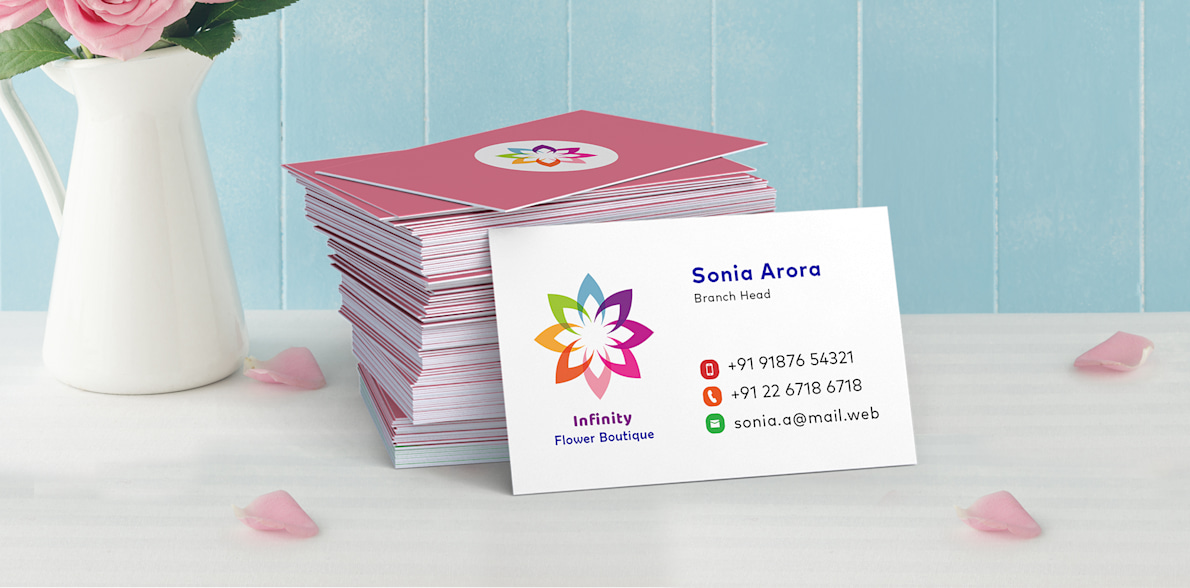VISITING CARD
INTRODUCTION – A visiting card is a small paper card with a person’s name on it. They were used to let someone know that another person had come to their home for a visit. Some visiting cards had just a name on them. Some also had images. Visiting cards are not used as much as they used to be.

PURPOSE OF VISITIONG CARDS –
< Marketing – Business cards are a key marketing tool for businesses, helping to get contact information into the hands of clients. They can also help create a positive image of professionalism, credibility, and loyalty, which can be important when potential clients are making decisions.
< Networking – Business cards can be a useful tool for networking, especially in a digital world where most transactions take place online. They can help people remember you and your contact information, which can be helpful when you need to follow up with someone in the future.
< Reminders – Business cards can be used as appointment reminders, for example, when you’re meeting with clients or partners. You can also leave them with other businesses to help increase sales and brand awareness.
< Digital experience – Business cards can include your website or social media handles, or a QR code that can open your site on a smartphone.
< Engagement – Business cards can encourage people to contact you, visit your business, and learn more about you. They can also help increase the likelihood that someone will contact you again.
TYPES OF VISITIG CARD

1) CLASSIC VISITING CARD
Personalized cards with a professional look.
<4000+ design options available
<Dimension shown on the design page includes bleed area (safety area), the final card size will be 9.1 x 5.5 cm
<Stretch your design up to the Bleed area to avoid white borders appearing around your card. Keep all your information within the safety area.
<Choose bold fonts size 10 and above when using white text
<Need help in designing? You can avail our DEEPAKPRINTOGRAPHIC

2) Matte Visiting Cards
Standout cards with a rich, polished look.
Available in 2 different paper stocks
<Standard Matte in 350 gsm with matte UV coating
<Premium Matte in 350 gsm with matte lamination
<Great for readability & easy to write on
<Choose from thousands of designs or upload your own
<Stretch your design up to the Bleed area to avoid white borders appearing around your card. Keep all your information within the safety area.
<Need help in designing? You can avail of our DEEPAKPRINTOGRAPHIC
Note: Please do not print designs belonging to Government/Quasi Government bodies

3) Rounded Corner Visiting Cards
Lose the corners. Get an edge
<0.6 cm rounded corners
<Dimension shown on the design page includes bleed area (safety area), the final card size will be 8.9 cm x 5.1 cm
<Stretch your design up to the Bleed area to avoid white borders appearing around your card. Keep all your information within the safety area.
<Choose bold fonts size 10 and above when using white text.
<Need help in designing? You can avail of our DEEPAKPRINTOGRAPHICS
<Note: Please do not print designs belonging to Government/Quasi Government bodies
The Evolution of Visiting Cards
The history of visiting cards, also known as business cards, can be traced back to 15th century China, where they were used for self-promotion and to build social and business relationships. These cards were called “Meishi” and were left with business owners, who would then decide if the card owner was worth meeting
In 17th century Europe, visiting cards became more popular, especially among aristocrats and royalty who used them to announce their arrival. These cards were often made of paper or wood, decorated with calligraphy, and sometimes engraved with gold. They were also used for other social interactions, such as dating, and were the size of a modern playing card. There was a lot of specific etiquette surrounding their use. For example, people would use visiting cards to request meetings with others, or to prove their credentials before entering an “elite establishment”.
By the late 18th and 19th centuries, visiting cards had evolved into the self-promotional tools we know today. They have continued to change over time, reflecting changes in society, technology, and etiquette. Today, business cards come in many different shapes and sizes, and have become a staple in networking and professional communication.
BUT,
Modern consumers want immersive and personalised experiences, and this marketing technology ticks these boxes. Unlike static paper versions, digital cards can include clickable links, allowing recipients to immediately visit your website, check out your social media profiles, or make a purchase.
BEST PRACTICES FOR USING VISITING CARDS
<Be politeAsk permission before giving someone your card and present it with one or two hands, depending on local customs.
<Keep it simple Include only essential information, such as your name, title, company, phone number, email, and website. You can also add your physical address and social media handles if you have space. Avoid cluttering your card, which can overwhelm the recipient.
<Consider the size The size of your card affects the amount of information you can include and the size of the text.
<Use white space Leaving some white space, or negative space, can make your card easier to read and create a clean design.
<Add a QR code QR codes can make it easy for people to find your website using their phone’s camera. They can also help you track engagement.
<Stay on brand Use your business card as a marketing tool to engage people with your brand.
<Use digital business cards Digital business cards are 100% paperless and can help reduce the environmental impact of printing paper cards.